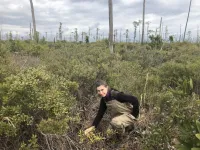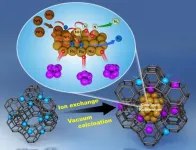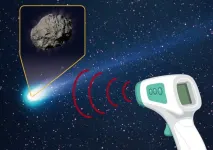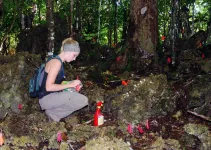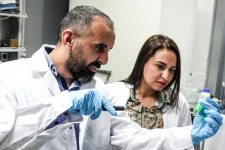Thinking with your stomach? The brain may have evolved to regulate digestion
Researchers from the University of Tsukuba find that sea urchin larvae use light to control digestion
2021-04-06
(Press-News.org) Tsukuba, Japan - Many life forms use light as an important biological signal, including animals with visual and non-visual systems. But now, researchers from Japan have found that neuronal cells may have initially evolved to regulate digestion according to light information.
In a study published this month in BMC Biology, researchers from the University of Tsukuba have revealed that sea urchins use light to regulate the opening and closing of the pylorus, which is an important component of the digestive tract.
Light-dependent systems often rely on the activity of proteins in the Opsin family, and these are found across the animal kingdom, including in organisms with visual and non-visual systems. Understanding the function of Opsins in animals from different taxonomic groups may provide important clues regarding how visual/non-visual systems evolved in different creatures to use light as an external signal. The function of Opsins in the Ambulacraria groups of animals, which include sea urchins, has not been characterized, something the researchers aimed to address.
"The functions of eyes and visual systems have been well-characterized," says senior author of the study Professor Shunsuke Yaguchi. "However, the way in which light dependent systems were acquired and diversified throughout evolution is unclear especially in deuterostomes because of the lack of data regarding the signaling pathway in the Ambulacraria group."
To address this, the researchers tested whether light exposure caused changes in digestive tract activity in sea urchins. They then conducted micro-surgical and genetic knockdown experiments to test whether Opsin cells in the sea urchin digestive system mediated the effect of light.
"The results provided new information about the role of Opsins in sea urchins," explains Professor Yaguchi. "Specifically, we found that stimulation of sea urchin larvae via light caused changes in digestive system function, even in the absence of food stimuli."
Furthermore, the researchers identified brain serotonergic neurons near the Opsin-expressing cells that were essential for mediating the light-stimulated release of nitric oxide, which acts as a neurotransmitter.
"Our results have important implications for understanding the process of evolution, specifically, that of light-dependent systems controlled via neurotransmitters," says Professor Yaguchi.
The data indicate that an early function of brain neurons may have been the regulation of the digestive tract in our evolutionary ancestors. Because food consumption and nutrient absorption are critical to survival, the development of a sophisticated brain-gut regulatory system may have been a major step in animal evolution.
INFORMATION:
The article, "Sea urchin larvae utilize light for regulating the pyloric opening" was published in BMC Biology at DOI:10.1186/s12915-021-00999-1
[Attachments] See images for this press release:

ELSE PRESS RELEASES FROM THIS DATE:
2021-04-06
LOS ANGELES (April 5, 2021) -- New research from the Smidt Heart Institute shows that more patients--specifically those with medical risk factors or from underserved communities--opted into telehealth appointments for their cardiovascular care during the COVID-19 pandemic. The data also suggests these telehealth patients underwent fewer diagnostic tests and received fewer medications than patients who saw their doctors in person.
The findings, published in JAMA (Journal of the American Medical Association) Network Open, point to "digital shifts" in cardiovascular care amid the ongoing COVID-19 pandemic.
"We were encouraged to learn that access to cardiovascular ...
2021-04-06
DURHAM, N.C. -- Emily Ury remembers the first time she saw them. She was heading east from Columbia, North Carolina, on the flat, low-lying stretch of U.S. Highway 64 toward the Outer Banks. Sticking out of the marsh on one side of the road were not one but hundreds dead trees and stumps, the relic of a once-healthy forest that had been overrun by the inland creep of seawater.
"I was like, 'Whoa.' No leaves; no branches. The trees were literally just trunks. As far as the eye could see," said Ury, who recently earned a biology Ph.D. at Duke University working with professors Emily Bernhardt and Justin Wright.
In bottomlands throughout the U.S. East ...
2021-04-06
Tsukuba, Japan - With a prevalence of about one in 10 people worldwide, chronic kidney disease (CKD) is a global health problem. It also often goes undetected, leading to a range of negative health outcomes, including death. Catching it at an early stage and adjusting nutrition and lifestyle can improve and extend life, but only if there are economically feasible systems in place to promote and educate on this.
Amid finite health-care resources, any CKD intervention must be both practical and cost-effective. A team of researchers centered at the University of Tsukuba now believe they have found a CKD behavioral intervention that can be delivered at a reasonable cost. They published their findings in the Journal of Renal Nutrition.
Changing eating and lifestyle habits, and ...
2021-04-06
For the implementation of the effective hydrogen economy in the forthcoming years, hydrogen produced from sources like coal and petroleum must be transported from its production sites to the end user often over long distances and to achieve successful hydrogen trade between countries. Drs. Hyuntae Sohn and Changwon Yoon and their team at the Center for Hydrogen-fuel Cell Research of the Korea Institute of Science and Technology (KIST) have announced a novel nanometal catalyst, constituting 60% less *ruthenium (Ru), an expensive precious metal used to extract hydrogen via ammonia decomposition.
*Ruthenium is a metal with the atomic number 44, and is a hard, expensive, silvery-white member of the platinum group of elements.
Ammonia has recently emerged as a liquid storage and transport ...
2021-04-06
Epidemiological studies have found that transportation noise increases the risk of cardiovascular morbidity and mortality, with high-quality evidence for ischaemic heart disease. According to the WHO, ?1.6 million healthy life-years are lost annually from traffic-related noise in Western Europe. Traffic noise at night causes fragmentation and shortening of sleep, elevation of stress hormone levels, and increased oxidative stress in the vasculature and the brain. These factors can promote vascular dysfunction, inflammation and hypertension, thereby elevating the risk of cardiovascular ...
2021-04-06
Humans have altered the ocean soundscape by drowning out natural noises relied upon by many marine animals, from shrimp to sharks.
Sound travels fast and far in water, and sea creatures use sound to communicate, navigate, hunt, hide and mate. Since the industrial revolution, humans have introduced their own underwater cacophony from shipping vessels, seismic surveys searching for oil and gas, sonar mapping of the ocean floor, coastal construction and wind farms. Global warming could further alter the ocean soundscape as the melting Arctic opens up more ...
2021-04-06
The world's first ground-based observations of the bare nucleus of a comet nearing the end of its active life revealed that the nucleus has a diameter of 800 meters and is covered with large grains of phyllosilicate; on Earth large grains of phyllosilicate are commonly available as talcum powder. This discovery provides clues to piece together the history of how this comet evolved into its current burnt-out state.
Comet nuclei are difficult to observe because when they enter the inner Solar System, where they are easy to observe from Earth, they heat up and release gas and dust which ...
2021-04-06
April 06, 2020-- A new commentary published online in the Annals of the American Thoracic Society provides an exhaustive examination of published research that discusses whether air pollution may be linked to worse COVID-19 outcomes. The studies that the authors examined look at several potential disease mechanisms, and also at the relationship between pollution, respiratory viruses and health disparities.
In "COVID-19 Pandemic: A Wake-Up Call for Clean Air," Stephen Andrew Mein, MD, Department of Medicine, Beth Israel Deaconess Medical Center, Boston, and colleagues ...
2021-04-06
A University of Guam review of published research on the critically endangered Serianthes nelsonii tree has revealed a reason why the population of the trees continues to be endangered despite a long history of funded conservation projects and a national recovery plan implemented 26 years ago. The review article, co-authored by biologists of the Plant Physiology Laboratory of UOG's Western Pacific Tropical Research Center, was published on March 2 in Horticulturae journal (doi:10.3390/horticulturae7030043).
"A main message of our paper is that decision-makers from funding agencies limit conservation success when practitioners ...
2021-04-06
A revolutionary technology developed within the END ...
LAST 30 PRESS RELEASES:
[Press-News.org] Thinking with your stomach? The brain may have evolved to regulate digestion
Researchers from the University of Tsukuba find that sea urchin larvae use light to control digestion


